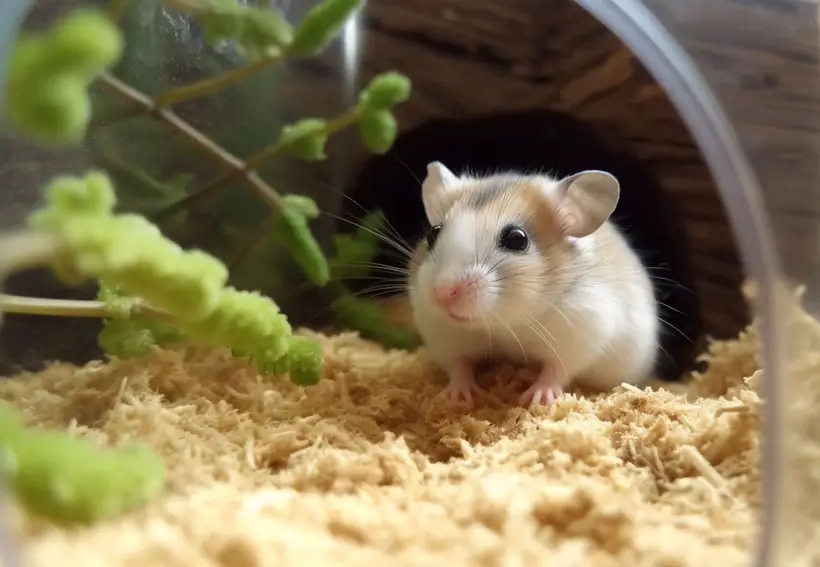Robo Dwarf Hamster Care: Food, Habitat, Health, and Facts + More Tips
Dwarf hamsters are tiny creatures no bigger than a thumb, but they’re very active, playful, and cute. A well-cared-for Robo is more conceivable to be happy, healthy, and live longer. Neglecting in their care can have severe consequences for their health and well-being.
So, what are some important considerations for Robo Dwarf hamster care? When caring for Robo hamsters, it’s essential to maintain a healthy diet, regular grooming, and a safe and comfortable living environment. Additionally, regular veterinary check-ups can help ensure their overall health.
However, this article will cover important facts about Robo dwarf hamsters. We’ll also provide tips on choosing the right food and housing for your Robo and how to spot and address any health concerns.
Overview of Robo Dwarf Hamster

Taking care of Hamsters will be much easier if you have a clear idea about them. So check out this information about hamsters to help you care for them better.
| Traits | Description |
|---|---|
| Common Name | Robo Hamster, Roborovski Hamsters |
| Life Span | 2-4 years on average |
| Size | 2-3 inches (5-7.5 cm) long |
| Weight | 20-25 g |
| Diet | Omnivorous |
| Behaviour | Nocturnal, social, active, and fast-moving |
| Natural Habitat | Desert |
| Temperament | Generally docile and friendly |
| Care Level | Beginner |
Dietary Care for Your Hamster

A balanced diet is essential for the health and well-being of your Robo Dwarf Hamster.
- These little creatures are omnivores, so they eat plants and animals.
- Their diet should include a variety of foods, such as fresh fruits and vegetables, high-quality hamster grains, and small amounts of lean protein, such as cooked chicken or boiled eggs.
- It’s important to avoid giving your hamster sugary or fatty treats, as these can lead to health issues such as obesity.
- Instead, provide occasional treats like small pieces of carrot, apple, or broccoli.
- Always provide fresh, clean water at all times, either through a water bottle or a shallow dish that cannot be tipped over.
- Change the water daily, and clean the water bottle or dish regularly to prevent bacterial growth.
Habitat

Maintaining a consistent temperature and environment for your hamster’s well-being is important.
- Any significant fluctuations in temperature or exposure to direct sunlight can cause stress and health problems for your pet.
- Hamsters are comfortable at room temperature of 25°-26°C. Temperatures more than 32.5°C reduce their life span.
- Keep their cage in a quiet area away from direct sunlight.
- You should also ensure that your hamster’s cage is well-ventilated and draft-free.
Size and Design
- The ideal cage size for Robo Dwarf hamsters is at least 360 square inches, with a minimum height of 24 inches.
- A glass or plastic aquarium tank or a wire cage with narrow spacing is recommended.
- Robo Dwarf hamsters are excellent climbers, so the cage should have multiple levels and platforms.
- Accordingly, the bedding material should be dust-free and absorbent, such as aspen shavings, paper-based bedding, or recycled paper products.
Decor
- Robo Dwarf hamsters are active and curious creatures that require hiding spaces, toys, and exercise wheels.
- So provide plenty of tunnels, hideouts, and chew toys to keep them entertained and prevent boredom.
Cleaning
- Regular cleaning of the cage is essential for the hamsters’ health and well-being.
- Remove any uneaten food, soiled bedding, and feces daily.
- A thorough cleaning of the entire cage should be done weekly or bi-weekly, depending on the number of hamsters and the cage size.
Health Care
Robo Dwarf hamsters are generally healthy pets, but like any other animal, they’re prone to certain health issues. Signs of a healthy Robo Dwarf hamster include bright and clear eyes, a shiny hair coat, and a healthy appetite.

Common Diseases and Symptoms
Some common health problems that Robo dwarf hamsters may experience include
- Respiratory infections
- Wet tail
- Actinomycosis
- Dental problems
- Constipation
- Skin infections
If you notice any of the following signs, it may be an indication of a health problem:
- Lethargy or lack of energy
- Decreased appetite or water intake
- Weight loss or gain
- Changes in fur texture or color
- Diarrhea or loose stools
- Sneezing, coughing, or wheezing
Tips on How to Prevent and Treat These Health Issues
- Maintain good hygiene by cleaning the cage regularly and providing clean and fresh water and food
- Provide a balanced and healthy diet
- Avoid sudden changes in diet, as this can cause digestive problems
- Seek veterinary care immediately if you notice any signs of a health problem
- Provide plenty of exercise and playtime
Regular Veterinary Checkup
- Regular check-ups with a veterinarian are important for maintaining your pet’s health and well-being. During these visits, your veterinarian can perform a comprehensive physical examination.
- They can administer vaccinations and treatments if necessary.
- Therefore, you should take your Robo to the veterinarian at least once a year, even if it appears healthy.
Warn Against Certain Household Items That May Be Harmful to the Hamsters
Certain household items can be harmful to them. For example, cedar and pine bedding can cause respiratory problems in hamsters. Here are a few more:

Barred and Meshed Wheels
It’s crucial to steer clear of barred and meshed wheels for hamsters. Their tiny paws can effortlessly slip through the openings, causing severe harm to their limbs. In most cases, the damage inflicted is irreparable, necessitating the amputation of the affected limb.
Hamster Balls
Due to poor eyesight, hamsters rely heavily on their sense of smell and touch to navigate and interact with their surroundings.
Unfortunately, when placed in a ball, they cannot engage with their environment, depriving them of mental stimulation and causing confusion and disorientation.
Exercise, Grooming, and Training
Hamsters are adorable and fun pets that require proper care and attention. Providing them with plenty of exercise, grooming, and training will keep them happy and more active.

Exercise
Robo dwarf hamsters are active and require plenty of opportunities to exercise and play. Providing a large, multi-level cage with plenty of toys, tunnels, and hiding spots is essential for your hamster’s mental and physical health.
Grooming
Hamsters are typically fastidious creatures and proficient in self-cleaning. They do not need to be bathed regularly. However, if dirt or particles are stuck in their fur, you can assist in cleaning by softly rubbing the affected area with a moist cloth.
They also love chewing on things, so providing them with wooden chews can help keep their teeth healthy and prevent them from becoming overgrown.
Check this video to show how to bathe a hamster –
Training
Start by offering them treats as rewards for good behavior. Once they’ve learned to associate a particular action with a reward, you can gradually introduce new commands. Keep training sessions short and positive to avoid stressing your hamster.
Breeding Care
- Summer and spring is the breeding season for them.
- Before breeding, ensure you have got a healthy pair of Robo Dwarf hamsters.
- Choose a male and female that are at least three months old and are not related. It’s best to introduce them gradually.
- If you own multiple hamsters, keep them separate or with the same sex if you don’t interested in breeding them.
Interesting Facts about Robo Dwarf Hamster

Here are some facts that you might not know about these adorable pets.
- Dwarf hamsters are the fastest species of hamster
- They aren’t very good at climbing
- Due to their natural habitat in the desert, these hamsters have developed a tolerance for low water availability
- They’re most active in the evening and morning times
- Hamsters receive mothers’ nursing until they are only 18 days old; from 20 days old, they live independently
- They’ve got a unique behavior called “sand bathing”, where they roll around in the sand to clean their fur
- Hamsters possess a natural ability to store food. Their cheeks act as small pouches that enable them to collect food up to a capacity equivalent to their body weight
- They’re capable of covering 100 miles within one night of running
- Robo hamsters don’t have any vocal cords; they communicate mostly through body language
- They’re polygynous means they’ve multiple sex partners.
FAQs
Find answers to some of the people’s most common questions about Robo dwarf hamster care.
Q. How often do you feed a robo-dwarf hamster?
A robo-dwarf hamster should be fed once a day, preferably in the evening. They should be given 1-2 tablespoons of hamster food, a hamster mix, and freshwater.
Q. Do roborovski hamsters bite?
Yes, but not usually. Every hamster has its own personality and temperament. However, they’re generally not known to bite unless they feel threatened or cornered.
Q. Does the Robo hamster like to be held?
Roborovski hamsters are social animals, and they tend to be happier and more active when kept in pairs or groups. Keeping a same-sex pair or group of Roborovski hamsters requires a larger cage and careful introductions to prevent aggression.
Conclusion
Proper Robo Dwarf hamster care requires attention to their food, habitat, and overall health. These small but active creatures need a spacious and stimulating environment that provides them with a balanced diet and regular exercise. They also need mental stimulation and social interaction to prevent boredom and promote health.
Understanding their behavior and unique characteristics can also help create a happy and healthy environment for your furry friend. With proper care and attention, Robo Dwarf hamsters can make wonderful and entertaining pets for all ages.




